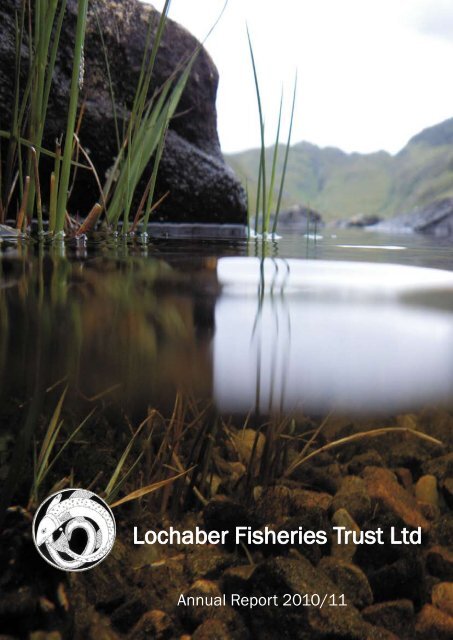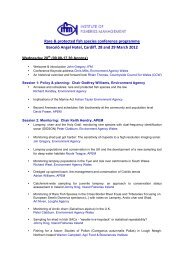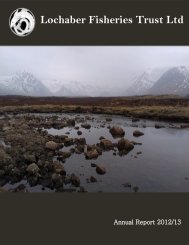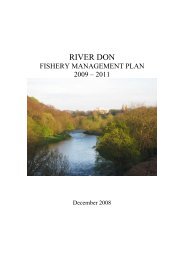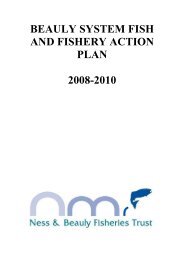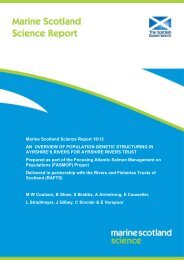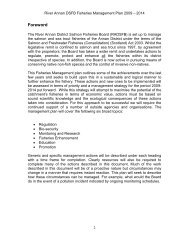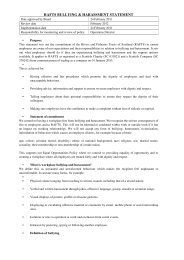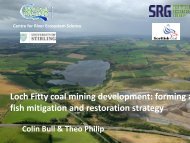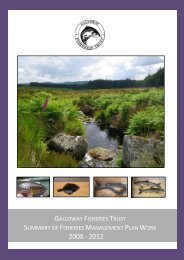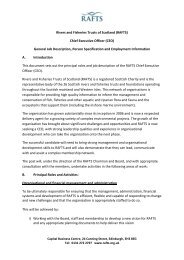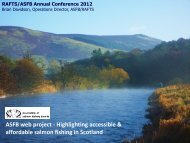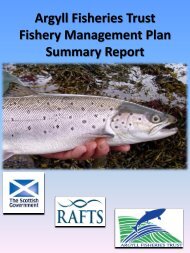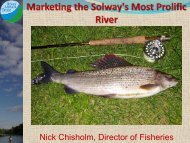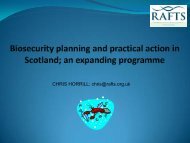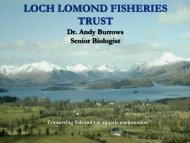You also want an ePaper? Increase the reach of your titles
YUMPU automatically turns print PDFs into web optimized ePapers that Google loves.
<strong>Lochaber</strong> Fisheries Trust Ltd<br />
<strong>Lochaber</strong> Fisheries Trust Ltd<br />
Annual Annual Report Report 2010/11 2010/11
The <strong>Lochaber</strong> Fisheries Trust<br />
Contents<br />
Chairman’s Report 1<br />
Understanding Sea Lice 2<br />
The <strong>Lochaber</strong> Fisheries Trust is a charity dedicated to<br />
improving and raising awareness of the fish populations and<br />
freshwater habitats of <strong>Lochaber</strong>. Since our formation in 1996<br />
we have worked with river owners, managers, anglers,<br />
government agencies and others to ensure that the region’s<br />
fresh waters are protected and managed sustainably.<br />
Restocking the Strontian 4<br />
Alien Invaders 5<br />
The Shiel Catchment 7<br />
Education and Outreach 9<br />
Grigadale Fish Pass 11<br />
Lundy Barrier Removal 12<br />
Eel Survey 13<br />
Accounts 14<br />
Acknowledgements 16<br />
Trust Directors: Viv de Fresnes (Chairman), Grace Henderson (Vice chairman), Sandy Grierson<br />
(Treasurer), Barbara Collins (Company Secretary), Simon Boult, Donnie MacBeth.<br />
Biologists: Diane Baum, Lucy Ballantyne<br />
The <strong>Lochaber</strong> Fisheries Trust is a company limited by guarantee with charitable status.<br />
Scottish Charity number: SC024490. Company registration number: 261988
Chairman’s Report<br />
It has been another busy and productive year for the <strong>Lochaber</strong> Fisheries<br />
Trust.<br />
Understanding the impact of sea lice and the interactions between farm<br />
salmon and wild fish remains a key priority for the Trust. In 2010 we have<br />
been assisting Marine Scotland Science with their ambitious project<br />
combining lice dispersion modelling, plankton trawls, smolt tracking and<br />
sentinel cages, which will make Loch Linnhe the most intensively studied area<br />
of Scotland for this issue. This will combine with the Trust’s ongoing<br />
monitoring of lice levels on sea trout post-smolts. Though the TWG ended in<br />
March 2011, this monitoring will continue through the Managing Interactions<br />
Project. This project will also produce guidance on the sensitivity of areas for<br />
aquaculture development for use by Council planners and look at genetic<br />
introgression of farm fish genes into wild salmon populations.<br />
The control of non-native invasive species is becoming an increasingly<br />
important part of the Trust’s work. A three year project to control Japanese<br />
knotweed on the River Lochy finished in 2010 and resulted in a significant<br />
decline in the area affected. This year the Trust has organised the training<br />
and equipping of volunteers to spray non-native species that will allow further<br />
work on the River Lochy and other catchments throughout <strong>Lochaber</strong>. In<br />
future years we hope to support and enhance mink control in <strong>Lochaber</strong> to<br />
reduce the impact of this alien species on fish populations and wider<br />
biodiversity.<br />
The removal of artificial barriers to migration is a very practical means of<br />
improving river habitats for fish. Last year the Trust completed two such<br />
projects: installing a fish pass on the Grigadale Dam and removing two<br />
barriers on the River Lundy. Both projects will open up significant areas of<br />
potential spawning and juvenile fish habitat upstream of the old barriers.<br />
Education and awareness raising continues to be a central part of the Trust’s<br />
work. Our long-running ’Salmon in the Classroom’ project with local primary<br />
schools continues to delight and inspire children. We have also worked with<br />
Highland Council Rangers and the National Trust Scotland to give visitors the<br />
opportunity to experience our fish fauna. In November we held our first<br />
seminar on the status of salmon and sea trout in <strong>Lochaber</strong>. Expert speakers<br />
were drawn from across Scotland to stimulate discussion on issues such as<br />
aquaculture, hydro schemes and genetics. Attendance at the event was<br />
excellent and all seemed to enjoy their day. Thanks to all involved.<br />
Thanks to all the Directors who give of their time for the Trust, but mostly to<br />
Dr Diane Baum and Lucy Ballantyne without whose hard work and<br />
enthusiasm none of this work would be possible.<br />
Viv de Fresnes<br />
Chairman<br />
Understanding Sea Lice<br />
The LFT are involved in an ambitious project led by Marine Scotland Science to improve our<br />
understanding of sea lice dynamics in Loch Linnhe and the impact they have on wild salmonids in the<br />
area. The project began in 2010 and consists of two complimentary strands - lice dispersion modelling<br />
and smolt tracking – in addition to the LFT’s ongoing lice monitoring of sea trout post smolts. Sea lice are<br />
the greatest potential impact of fish farms on wild salmonids and through this project Loch Linnhe will<br />
become one of the best studied areas in Scotland for the interactions between farms, lice and wild<br />
salmonids.<br />
Lice dispersion modelling<br />
Each female louse can produce up to 4000 eggs,<br />
which develop into plankton larvae. These<br />
larvae have some ability to move through the<br />
water column, but they are largely at the mercy<br />
of currents and wind movement as they are<br />
Plankton samples will be collected in 2011 to<br />
validate the plankton dispersion model<br />
spread through the water in search of a<br />
salmonid host. Given their high concentration<br />
of contained salmon, fish farms in Loch Linnhe<br />
are predicted to be by far the greatest source of<br />
lice in the loch. With sufficient knowledge of<br />
water currents and wind movements, it is<br />
possible to predict how planktonic lice would<br />
disperse from fish farms and distribute<br />
themselves around the loch. Similar work has<br />
been carried out in Loch Shieldaig in Wester<br />
Ross and suggested that certain areas of the<br />
loch can become lice ‘hotspots’ where the<br />
infection risk for salmonids would be particularly<br />
high.<br />
Using existing water current data collected by<br />
SAMS, Marine Scotland Science have produced<br />
the first version of a lice dispersion model for<br />
Loch Linnhe. In 2011 the model will be validated<br />
to ensure it accurately predicts lice distribution in<br />
the loch. Plankton samples and sentinel cage work<br />
will be used to validate the model. <strong>Lochaber</strong><br />
Fisheries Trust will be able to help in this process<br />
by collecting the plankton samples. A robust lice<br />
dispersion model will allow us to predict the<br />
impact of existing farm sites and any future<br />
aquaculture restructuring on lice densities and<br />
distribution in Loch Linnhe.<br />
Smolt tracking<br />
The lice dispersion model will enable us to predict<br />
where the highest planktonic lice densities are<br />
found in Loch Linnhe, but without knowledge of<br />
the route and speed of salmon and sea trout<br />
smolt migration, it is impossible to predict their<br />
risk of exposure to infective lice. Sadly smolts are<br />
very difficult to track after they leave the river.<br />
Their small size limits the tags that can be used<br />
and consequently the distance over which they<br />
can be detected. This study uses hydroacoustic<br />
tags that are inserted into smolts and detected by<br />
fixed receivers placed in Loch Eil and upper Loch<br />
Linnhe as far south as the Corran Narrows.<br />
Seine netting for smolts<br />
1 2
Understanding Sea Lice<br />
Restocking the Strontian<br />
Screw traps were one method used to catch smolts for<br />
tagging, the fish get channelled through the “drum into<br />
a storage chamber at the back<br />
In 2010 a total of 20 hatchery-reared salmon<br />
smolts from the Lochy, ten wild salmon from the<br />
Gionn Lighe and 40 wild sea trout from the Fionn<br />
Lighe and Camas na Gaul were tagged. Their<br />
movements in Loch Eil and upper Loch Linnhe<br />
were tracked for the first couple of months at<br />
sea. Sea trout showed a much greater tendency<br />
to remain close to their natal river and there was<br />
little movement between Loch Eil or Linnhe<br />
during the tracking period. After a few days near<br />
the river mouth, salmon smolts generally moved<br />
quickly down the loch and through the Corran<br />
Narrows. In spring 2011 50 wild salmon smolts<br />
and 50 wild sea trout smolts will be tagged to<br />
increase the sample size.<br />
Sea trout lice monitoring<br />
The LFT have been monitoring lice levels on sea<br />
trout post-smolts since 1999. The results from<br />
the 2010 sampling were in line with the biennial<br />
pattern of lice abundance and prevalence seen<br />
since the sampling began. A higher percentage of<br />
fish carry lice and lice burdens are greater when<br />
neighbouring farms are in their second year of their<br />
production cycle. There has been a general<br />
reduction in lice levels over the years we have been<br />
sampling, but we still catch fish with lice burdens<br />
that are above those known to cause stress and<br />
mortality.<br />
We hope the smolt tracking work will give us more<br />
information about the movements of sea trout in<br />
the Loch Eil and Loch Linnhe area so we can see<br />
how far they range in their first few months at sea.<br />
This coupled with the lice dispersion model will<br />
allow us to assess where they are most likely to be<br />
exposed to lice.<br />
Until 2010 our post-smolt netting was funded by<br />
the Tripartite Working Group. This has now been<br />
Ovigerous louse clearly visible on a sea trout post-smolt. Earlier<br />
life-stages were also found on the fins of this fish. This fish<br />
had relatively few lice compared to some caught later in the<br />
season.<br />
disbanded and in 2011 lice monitoring will form<br />
part of the Aquaculture Project set up by Marine<br />
Scotland, <strong>RAFTS</strong> and six fisheries trusts on the west<br />
coast. The LFT will continue to attend Area<br />
Management Group meetings involving local<br />
aquaculture and wild fish interests.<br />
The salmon population on the Strontian River is virtually extinct. No salmon has been caught on<br />
the river in five years and our electrofishing surveys have shown that juvenile densities are<br />
perilously low. The LFT has been assisting the Strontian Community Company and Strontian<br />
Angling Club as they work hard to restore their salmon population.<br />
A review of the river published in 2007<br />
suggested the freshwater habitat was in good<br />
condition and able to sustain a salmon<br />
population. Poor marine survival has depressed<br />
many salmon populations on the west coast of<br />
Scotland, but while some have shown signs of<br />
improvement in recent years, it appeared that<br />
the Strontian population had dropped so low<br />
that total extinction was highly probable<br />
without intervention. Stocking was felt to be<br />
the only option, and rearing on parr from the<br />
river the only means of obtaining native<br />
broodstock.<br />
Diane taking genetic samples and inserting PIT<br />
tags into the future brood stock.<br />
In August 2010 the LFT electrofished the river<br />
and 32 parr were taken into the Strontian<br />
hatchery. Parr were also taken from the<br />
neighbouring Carnoch river to provide a wider<br />
gene pool if necessary.<br />
All the parr are individually marked using PIT tags<br />
and adipose fin clips have been taken from them<br />
for genetic analysis. Escaped farm fish have been<br />
caught in the Strontian and we need to ensure no<br />
farm-origin fish are used in the stocking<br />
programme. Previous genetic analysis carried out<br />
on Strontian parr suggested that they are very<br />
different from other salmon in <strong>Lochaber</strong>, but it was<br />
not possible to say for sure whether this was due to<br />
farm fish influence or intense inbreeding. A new<br />
genetic technique has recently been developed in<br />
Norway specifically to distinguish between wild and<br />
farm salmon. In 2011 the Strontian parr will be<br />
tested using this technique.<br />
Electrofishing for parr<br />
For now the parr are thriving at the Strontian<br />
hatchery thanks to the dedication of Pete Madden<br />
and other members of the angling club. In the<br />
future the information provided by the genetic<br />
analysis will allow us to weed out any farm-origin<br />
fish and plan a breeding strategy that maximises<br />
genetic diversity in the next generation to be<br />
stocked back into the river.<br />
3 4
Alien Invaders<br />
Alien Invaders<br />
Non-native, invasive species are one of the greatest threats to wildlife across the globe and the rivers and<br />
lochs of <strong>Lochaber</strong> are not immune to the damage they can cause. Alien plants are already established and<br />
spreading in many of our catchments and if other potential invaders got a foothold, the results could be<br />
devastating. The LFT have been working to both contain established non-natives and raise awareness<br />
about the enemies at the gates.<br />
Japanese and giant knotweed will be familiar to<br />
anyone who has fished the Lochy or driven along<br />
the A82 south of Fort William. Like so many nonnative<br />
plants, it was first brought to Britain by<br />
Victorian gardeners and soon hopped over the<br />
garden fence and along river banks, railways and<br />
road verges. This pernicious weed grows<br />
incredibly quickly and can sprout from any small<br />
fragments broken and washed downstream or<br />
moved with soil. The most extensive stands in<br />
<strong>Lochaber</strong> are around Fort William, but it is found<br />
as far afield as Mallaig, Lochaline, Strontian,<br />
Duror, Kinlochleven and even Loch Teacuis.<br />
In 2010 the LFT organised a training course for<br />
volunteers interested in controlling knotweed on<br />
their rivers funded by a grant from the SEPA<br />
Restoration Fund. Because knotweed spreads so<br />
readily from fragments, cutting is liable to<br />
exacerbate the problem. Treatment with<br />
glyphosate (also known as roundup) is the only<br />
effective means of control and all our volunteers<br />
as well as Lucy and Diane now hold a City and<br />
Guilds qualification for spraying herbicides close<br />
to watercourses. These qualifications have<br />
already been put to good use, though it may take<br />
a number of years of dedicated effort to get on<br />
top of the problem.<br />
The effort and commitment required to eradicate<br />
knotweed is illustrated by the work we have been<br />
doing on the Lochy with the River Lochy<br />
Association and funding from The Esmée Fairbairn<br />
Foundation. Knotweed along the river has been<br />
sprayed with herbicide repeatedly over three<br />
years and we are finally starting to see the fruits<br />
of this labour. The priority has been to rid the<br />
upper river of knotweed to prevent it recolonising<br />
areas downstream following floods. Monitoring<br />
carried out by the LFT has shown that most stands<br />
of knotweed in the upper catchment have been<br />
Japanese knotweed before and after treatment. The knotweed<br />
took three years of spraying to get to the “after”<br />
stage. Treatment is most effective in July by which time the<br />
plants are up to 3m high<br />
drastically reduced in size or eliminated<br />
completely. There are a few last remnants, but<br />
these have been mapped and will be targeted in<br />
the coming year. The ambitious aim for the future<br />
is to replicate this success in the lower reaches of<br />
the river where there are still large areas of<br />
knotweed that need tackling.<br />
It will take many years to eradicate knotweed on<br />
the Lochy and clearly it would be much simpler if<br />
the problem could be nipped in the bud and<br />
treatment applied before the species can become<br />
established and spread through a catchment. This<br />
requires good information and the LFT is trying to<br />
put together a comprehensive database of nonnative<br />
invasive species in <strong>Lochaber</strong>. Early<br />
detection is crucial, so if you know of any<br />
knotweed, Himalayan balsam or giant knotweed<br />
in the region, please let us know. We can also<br />
provide more information about identifying nonnative<br />
species and the best methods of controlling<br />
them.<br />
Himalayan Balsam growing along a watercourse<br />
<strong>Lochaber</strong> is thankfully free of many species that<br />
pose a serious threat to our freshwater habitats<br />
and fish populations. However, we can’t afford to<br />
be complacent since there is the risk of them<br />
spreading and the impact of some invaders could<br />
be catastrophic. Anglers may have seen signs<br />
produced by the Association of Salmon Fishery<br />
Boards warning of the danger of Gyrodactylus<br />
salaris. This tiny parasite spread from the Balkans<br />
to Norwegian rivers and caused the collapse of<br />
many fish stocks and necessitated the poisoning<br />
of entire rivers to eradicate it. Gyrodactylus is not<br />
present in Scotland, but the risk is there and<br />
government contingency plans are in place to<br />
contain any invasion.<br />
There is also intense interest in American signal<br />
crayfish, which eat salmon eggs, compete with<br />
parr and destabilise river banks. These are<br />
present in Scotland and the closest populations to<br />
us are in Argyll and Inverness-shire. For both<br />
species the options for control are so drastic that<br />
prevention is by far the best option. All water<br />
users can play their part by ensuring their clothing<br />
and equipment is disinfected or dried for many<br />
days as they move between river catchments. The<br />
LFT spray their equipment with the widelyavailable<br />
disinfectant Virkon to ensure we don’t<br />
spread anything in the course of our work.<br />
NEWS FLASH!<br />
Signal Crayfish have been found in<br />
Ballachullish Quarry, the most northerly<br />
recorded occurrence of this species on the west<br />
coast. Initial findings suggest they are an<br />
isolated population and so have almost<br />
certainly been introduced to the site by humans.<br />
The quarry has not been closed to the public but<br />
signs have been erected reminding visitors of<br />
the precautions to prevent the spread of<br />
crayfish. It is important to remember that it is<br />
illegal to catch or remove crayfish in Scotland<br />
without a license.<br />
We would be interested to hear from anyone<br />
who thinks they have spotted crayfish<br />
anywhere else in <strong>Lochaber</strong>. We are hoping they<br />
will stay contained in Ballachullish Quarry<br />
until an appropriate solution has been agreed<br />
upon.<br />
5 6
The Shiel Catchment<br />
The Shiel is one of the largest river catchments in <strong>Lochaber</strong>. It is dominated by Loch Shiel, a deep,<br />
nutrient-poor loch that supports excellent brown trout as well as sea trout and salmon fishing. The<br />
main River Shiel is the focus for the salmon and sea trout fishery, but fish are also taken on the Polloch<br />
River and Loch Doilet. In 2010 the LFT undertook a number of studies to improve our understanding<br />
and help improve the Shiel catchment.<br />
Electrofishing is a means of monitoring the health of salmon and trout<br />
populations by recording the density of juveniles in rivers and burns. In 2010<br />
we undertook a comprehensive survey of the major tributaries of Loch Shiel,<br />
recording juvenile densities at 30 sites on 17 watercourses. Tributaries lower<br />
down the catchment had the highest densities of fry and appeared to be the<br />
most important for spawning, but overall juvenile salmon and trout densities<br />
were only poor to fair across the catchment.<br />
Salmon fry densities have been mapped, the larger the dot the higher the<br />
density<br />
1. Farmed salmon smolts are reared in open net cages at two<br />
sites in Loch Shiel. We have been investigating the impact of<br />
the cages near Glenfinnan on the wild trout population. Food<br />
pellets and fish faeces are able to fall through the cages and<br />
into the loch, potentially affecting the local food-web and<br />
nutrient levels. Our work shows that wild trout are feeding<br />
directly on pellets and appear to have faster growth rates than<br />
trout in other parts of the loch. 1<br />
2<br />
2. Large trout have been seen<br />
ascending the River Finnan at spawning<br />
time for a number of years. We<br />
snorkelled the river in October and<br />
November to provide accurate counts of<br />
the brown trout, sea trout and salmon.<br />
The presence of large trout on what have<br />
traditionally been salmon spawning<br />
grounds could lead to problems of<br />
competition, overcutting and hybrids. In<br />
2010 we electrofished fry form the river<br />
and these will be genetically analysed to<br />
identify the proportion of trout-salmon<br />
hybrids. In 2011 we hope to radiotrack<br />
large trout up the river to get more<br />
detailed information about when and<br />
where they are spawning.<br />
4. Though small, the numerous burns entering Loch<br />
Shiel can provide valuable spawning habitat<br />
particularly for sea trout.<br />
In 2011 we carried out<br />
habitat surveys on the lower reaches of burns entering<br />
the southeast corner of Loch Shiel. Some of these<br />
burns have been affected by forestry operations and we<br />
are looking at possible measures to improve them with<br />
Forestry Commission.<br />
4<br />
As part of our biosecurity work we<br />
are trying to eradicate Japanese<br />
Knotweed from the Shiel catchment.<br />
It is currently only present in the<br />
southeast corner of the Shiel.<br />
3<br />
4<br />
3<br />
3. The Rivers Hurich and Polloch form the most<br />
important salmon nursery area in the Shiel<br />
catchment. The area is heavily forested and past<br />
studies have shown the water is more acidic than<br />
most other rivers in <strong>Lochaber</strong>. Over many years the<br />
LFT has been working with Forestry Commission<br />
who own Glen Hurich to restructure the forestry for<br />
the benefit of fish and the freshwater habitat.<br />
Conifers close to the bank have been removed from<br />
many sections of the river to reduce shading and<br />
create a buffer zone of native, broadleaf trees. In<br />
spring 2011 we revisited the river and updated the<br />
habitat survey to allow new priorities for action to<br />
be identified. This work will be written up in the<br />
coming year and will guide future FC operations.<br />
7 8
Education and Outreach<br />
Education and Outreach<br />
A major part of the LFT‟s remit is to educate the public about fish, freshwater environments and the<br />
threats they face. This ranges from our structured schools project – “Salmon in the Classroom” - to informal<br />
chats with interested members of the public on the riverbank. Providing information to river owners,<br />
managers and anglers on current fisheries research and best-practice management techniques is an<br />
important part of our work.<br />
Salmon in the Classroom<br />
Well, for many of the schools involved this year it<br />
was actually Trout in the Classroom as Drimsallie<br />
hatchery couldn’t provide us with salmon eggs this<br />
year. Many thanks to both Delfour Hatchery who<br />
very kindly provided us with trout eggs for 7 local<br />
schools, and Torlundy Trout Fishery who let us<br />
stock the young trout into one of their lochs.<br />
Thanks also to Gordon at Loch Shiel Estate<br />
hatchery and also Ardtornish estate for their<br />
salmon eggs.<br />
This project has<br />
been running for<br />
several years now,<br />
and is very popular<br />
with both pupils and<br />
teachers alike! Each<br />
year ten local<br />
primary schools are<br />
given a minihatchery<br />
in which to<br />
raise 100 salmonid<br />
e g g s . T h e<br />
responsibility for<br />
keeping the eggs cool, dark and oxygenated, and<br />
for removing any dead eggs is left with the<br />
children. To generate some healthy competition, a<br />
trophy is awarded to the school with the highest<br />
survival rate. Most schools in <strong>Lochaber</strong> have been<br />
involved in the project more than once and the<br />
pupils are obviously becoming expert hatchery<br />
operators! Each year the survival rate is going up<br />
and this year our trophy winners, Acharacle<br />
Primary School, managed to keep ALL their eggs<br />
alive, closely followed by Caol and Upper<br />
Achintore schools who managed 99% survival of<br />
trout eggs! That is a much better survival rate<br />
than most professional hatcheries achieve so the<br />
pupils should all be proud of themselves.<br />
Salmon are speckled<br />
Awesome, active.<br />
Leaping,<br />
Mighty and massive,<br />
Over obstacles to return to<br />
Native streams<br />
As well as the hatchery the project also consists of<br />
educational talks, games and field trip visits for<br />
each school. Fieldwork consists of a release day<br />
when schools release their hatched fish and a day<br />
in June when pupils get to take part in<br />
invertebrate and fish sampling. This year the<br />
trout were released into a loch at Torlundy Trout<br />
Fishery and pupils found a massive variety of<br />
wildlife in the pond, including frogs, newts and<br />
dragonfly larvae.<br />
Collecting and identifying inverts<br />
We encourage pupils to express what they have<br />
learnt about salmon/trout by running poetry and<br />
art competitions. This year the poetry was to be<br />
based on the salmons lifecycle and the art<br />
competition about the salmon/trout’s<br />
environment. We received some amazing poems<br />
and artwork, a selection of which can be seen on<br />
our website. The winners were Claire Ford,<br />
Acharacle Primary (Art, above left) and Jean<br />
Campbell, Strontian Primary (Poetry, above).<br />
Family fun days<br />
Electrofishing never fails to excite interest in<br />
children and adults alike. The mere idea of two<br />
people standing in water they are pumping 400<br />
volts through is interesting enough. But it is the<br />
best way to let people see the young salmon and<br />
trout, eels and stickleback that often go unnoticed<br />
in our rivers. Each summer we take part in a<br />
family days run by the Nevis Rangers, Forestry<br />
Commission and the National Trust Scotland. As<br />
well as electrofishing we will kick sample and<br />
examine invertebrates in the river and play games<br />
based on the salmon life cycle and fresh-water<br />
food webs. All of it is designed to show people<br />
that fish are fascinating, fragile and fun.<br />
Family fun day Glen Nevis<br />
Fisheries Management Workshop<br />
We held our first Fisheries Management workshop<br />
in November 2010, and it was a great success. The<br />
focus of the event was “The Plight of our Salmon”<br />
and looked at local issues affecting salmon and<br />
sea trout survival in <strong>Lochaber</strong>. Over 60 people<br />
attended the event, which consisted of 6 formal<br />
talks from speakers eminent in their field. The day<br />
kicked off with an overview of the health of<br />
salmon and sea trout stocks in Scotland, and<br />
changes in their populations over the last 50 years<br />
given by Andrew Wallace (chairman of <strong>RAFTS</strong>/<br />
ASFB).<br />
Next up was Brian Dornan, from Scottish<br />
Government to discuss government’s policy and<br />
regulation of aquaculture. Lucy Webster,<br />
Seminar poster<br />
geneticist from <strong>RAFTS</strong> gave a fascinating insight<br />
into the work being done on salmonid genetics in<br />
<strong>Lochaber</strong>. Jon Gibb, LDSFB talked about his<br />
stocking program on the River Lochy. Lunch gave<br />
everyone a chance for informal discussion and the<br />
speakers were kept busy with questions! After<br />
lunch Stewart Middlemas (Marine Scotland<br />
Science) gave a talk on salmonid predators and<br />
how these could be monitored and controlled.<br />
Next up an open discussion session on hydro’s<br />
which should have been delivered by Bob Morgan<br />
who sadly couldn’t make it. We used his<br />
presentation to guide our discussions and with the<br />
help of attendees who had experience in hydro<br />
schemes and a very interesting discussion<br />
developed. Last up was Diane Baum (LFT) who<br />
gave a short talk on what the Trust was doing to<br />
try and minimise the impact of all the threats to<br />
salmonids, and how people could get involved in<br />
this work by becoming members/volunteers. The<br />
day was rounded off by a big thanks to all the<br />
speakers and to the attendees for supporting the<br />
event.<br />
Many thanks to the Rod & Gun for acting as an<br />
outlet for ticket sales.<br />
9 10
Grigadale Fish Pass<br />
Lundy Barriers<br />
Artificial barriers to migration are a serious threat to our fish populations, restricting their distribution and<br />
denying them access to important areas of spawning and juvenile habitat. In 2010 the LFT completed two<br />
projects to restore fish access to the Allt Grigadale and River Lundy.<br />
The Allt Grigadale is a small river at the very westernmost point of the Ardnamurchan peninsula. The river<br />
was dammed in the 1920s creating Loch Grigadale and preventing salmon and sea trout ascending to the<br />
upper catchment. The dam is only 1.8m high, but its vertical face and lack of pool below it make it<br />
impossible to jump.<br />
Though small, the Allt Grigadale is an<br />
internationally important site because of the<br />
freshwater pearl mussels it supports. These longlived,<br />
endangered invertebrates rely on juvenile<br />
salmonids as a host for their parasitic larval phase,<br />
providing both a safe early environment and<br />
means of dispersion. Unfortunately the density of<br />
juvenile salmon and trout on the Grigadale are<br />
below the level thought to be required for the<br />
perpetuation of the mussel population, and there<br />
is evidence that young mussels are scarce in the<br />
catchment. Measures were needed to improve<br />
the salmonid population on the river, and opening<br />
up access to migratory fish was a key part of this.<br />
In 2006 Scottish Natural Heritage commissioned a<br />
report to look at the options and feasibility of<br />
restoring fish access to the upper Allt Grigadale.<br />
Removing the dam would have destroyed Loch<br />
Grigadale, which had become an important<br />
landmark and habitat for aquatic plants and<br />
animals in the decades since it was created.<br />
Installing a Denil fish pass on the dam was seen as<br />
the best option and a project was set up led by<br />
the LFT with funding from SNH and the SEPA<br />
Restoration Fund to achieve this.<br />
Freshwater pearl mussels<br />
Surveys of the fish and mussel populations of the<br />
river were conducted in 2009 and 2010 to provide<br />
baseline data and ensure the engineering work<br />
Denil fish pass giving migratory salmonids access to the<br />
upper grigadale catchment, important for pearl mussels.<br />
would not damage either. Once it was established<br />
no mussels or important habitats were present<br />
below the dam, installation could begin. The<br />
metal chute and baffles that slow the water flow<br />
were fabricated off-site, then slotted into place on<br />
the dam and encased in concrete. All the work<br />
was carried out extremely carefully with stringent<br />
measures put in place to prevent any sediment or<br />
concrete being washed downstream.<br />
On the 30 th August the fish pass was completed<br />
allowing salmon and sea trout to access the upper<br />
catchment for the first time in over 80 years.<br />
Electrofishing surveys of the upper Grigadale in<br />
2011 will tell us whether any salmon took<br />
advantage of this opportunity. It is hoped that<br />
future monitoring will find improved salmonid<br />
densities in the catchment with a consequent<br />
increase in juvenile pearl mussel numbers.<br />
Two old barriers were present in the middle<br />
reaches of the River Lundy, an important<br />
spawning tributary of the River Lochy. One dated<br />
from the 1930s and was part of a now defunct<br />
hydroelectric scheme for Inverlochy Castle. The<br />
upper dam was built in the 1950s to provide<br />
domestic water supply to neighbouring houses,<br />
but this had also fallen into disuse. Both dams<br />
were owned by Forestry Commission who were<br />
keen to remove them.<br />
Before and after removal of upper barrier<br />
Habitat surveys undertaken in 2009 showed that<br />
4km of river with significant areas of juvenile and<br />
spawning habitat could be opened up if the<br />
barriers were removed. This helped us to secure<br />
money from the SEPA Restoration Fund and<br />
Forestry Commission to engage an engineer to<br />
consider the various options for barrier easement.<br />
The scoping study suggested removal was the best<br />
solution for both barriers. It also highlighted<br />
complications caused by the large amount of<br />
sediment that had built up behind both dams and<br />
the difficulty of site access for the required<br />
machinery.<br />
In July 2010 work began to remove the dams.<br />
Forestry Commission cleared conifers from the<br />
banks of the Lundy to allow machinery to access<br />
both dam sites. Sediment that had built up<br />
behind the upper dam was dug out before the<br />
dam itself was broken up and the concrete<br />
removed from the site. It is now almost<br />
impossible to tell there was ever a dam present.<br />
Removal of the lower dam material was not<br />
possible due to the restricted access at this site.<br />
Instead a large section at the centre of the dam<br />
was broken up and the material moved to the side<br />
of the river. This created a wide channel through<br />
which fish can easily pass.<br />
Before and after the lower dam was removed<br />
LFT will conduct Redd surveys and electrofishing<br />
in future years to allow us to assess whether<br />
salmon have managed to successfully recolonise<br />
the upper River Lundy.<br />
11 12
Eel Survey Accounts 2010/11<br />
In 2010 the LFT completed its three year study of eel populations in <strong>Lochaber</strong>’s rivers funded by SNH. Eels<br />
have been in serious decline across Europe, but there is little reliable information on their numbers in Scotland.<br />
Our study addresses this knowledge gap and provides baseline data against which future trends can<br />
be measured.<br />
Of the eleven river catchments included in this<br />
survey, eels were recorded in all but one of them.<br />
No eels were caught in tributaries of Loch Morar<br />
we surveyed, but eels are known to be present in<br />
the loch. Densities of eels varied greatly between<br />
the rivers and survey sites we looked at, with the<br />
Rivers Moidart and Strontian having particularly<br />
healthy populations. It was also encouraging to<br />
find so many young eels in the survey. Large<br />
numbers of small eels that had recently entered<br />
freshwater following their migration across the<br />
Atlantic were found in the Rivers Lochy and Shiel<br />
and eels estimated to be less than 4 years old<br />
were found in nine of the 11 catchments<br />
surveyed. Clearly eel recruitment is still occurring<br />
in <strong>Lochaber</strong>. The oldest eel recorded in this<br />
survey was estimated to be at least 28 years old<br />
based on its length.<br />
There is no commercial fishery for eels in<br />
<strong>Lochaber</strong>, one of the main reasons for the eel’s<br />
decline in many European rivers. However, our<br />
eels will be vulnerable to any changes in ocean<br />
currents affecting elver migration and could suffer<br />
high mortality due to hydroelectric schemes.<br />
Anecdotal reports suggest that the spectacular<br />
elver migrations witnessed in the past no longer<br />
occur in <strong>Lochaber</strong>. It would be complacent to<br />
think that <strong>Lochaber</strong>’s eels are healthy and we<br />
intend to use this survey to identify future trends<br />
in numbers. The survey method we used –<br />
electrofishing in rivers and burns – excludes<br />
important still water eel habitats, but it has the<br />
advantage that it will be repeated in future years<br />
for juvenile salmonid surveys and so allow<br />
ongoing monitoring of the eel population.<br />
The full eel survey report can be downloaded from<br />
our website.<br />
Density of eel populations in <strong>Lochaber</strong>, 2010. The larger the dot the greater the density of<br />
eels. Red dots indicate no eels were found during the survey.<br />
LOCHABER FISHERIES TRUST LTD<br />
(A company limited by guarantee)<br />
Detailed statement of financial activities<br />
For the year ended 31 March 2010/11<br />
2011 2010<br />
Incoming resources £ £<br />
Incoming resources from generating funds<br />
Voluntary income<br />
Donations-Lisbet Rausing 1 000 1 000<br />
Donations-Whitley Animal Trust (via <strong>RAFTS</strong>) 744 845<br />
Donations-other 1 750 30<br />
Total 3 494 1 875<br />
Bank interest payable 41 35<br />
Total incoming resources from generating funds 3 535 1 910<br />
Incoming resources from charitable activities<br />
Subscriptions/Angling Clubs 520 85<br />
Riparian Owners 5 775 6 539<br />
Invoiced projects 9 248 5 160<br />
HIE-AMA 34 615 26 884<br />
Special projects-Scottish Government block grant 9 486 12 206<br />
Special projects-SNH (Eel survey) 4 109 4 109<br />
Special projects-(SNH Freshwater Mussels) 0 5 000<br />
Special projects-Mackintosh Foundation (Morar) 1 000 1 000<br />
Special projects-SNH (Salmon in the Classroom) 4 563 4 251<br />
Special projects-Scottish Water (Lochy catchment) 0 30<br />
Special projects-SNH (invertebrate) 0 2 000<br />
Special projects-TSL Hydro 0 2 866<br />
Special projects-Dubh Lighe 0 3 745<br />
Special projects-Wildfowl and Wetlands Trust 0 2 986<br />
Special projects– Atlantic Salmon Trust 0 712<br />
Special projects-Electrofishing survey 0 10 866<br />
Special projects - Biosecurity Plan 5 204 5 294<br />
Special projects-Esmee Fairbairn Foundation 0 2 828<br />
Special projects—Shiel project 14 543 0<br />
Special projects—Grigadale dam 42 735 0<br />
Special projects—River Lundy Barrier Removal 8 135 0<br />
Special projects—Tag program 15 392 0<br />
D/O repayments<br />
0 3 224<br />
Total incoming resources 156 820 83 207<br />
13 14
Accounts 2009/10<br />
Acknowledgements<br />
LOCHABER FISHERIES TRUST LTD<br />
(A company limited by guarantee)<br />
Detailed statement of financial activities<br />
For the year ended 31 March 2011<br />
2011 2010<br />
Resources expended £ £<br />
Charitable activities<br />
Activities undertaken directly<br />
The <strong>Lochaber</strong> Fisheries Trust is very grateful for the support of the following organisations and individuals<br />
over the past year:<br />
Ardtornish Estate<br />
The Crown Estate<br />
Esmée Fairbairn Foundation<br />
Forestry Commission Scotland<br />
Alasdair Boulton<br />
Stuart Brabbs<br />
Ewen Cameron<br />
Gerald Collins<br />
Wages & Salaries 45 980 43 416<br />
Employers NIC 4 423 4 260<br />
Pension costs 1 140 1 140<br />
Contract Staff 1 255 910<br />
Rent 2 000 1 916<br />
Repairs & Renewal (Sc) 779 1 203<br />
Insurance 1 761 2 033<br />
Repairs & Renewal (Off) 410 300<br />
Motor & travel 9 442 2 586<br />
Vehicle lease 3 159 6 160<br />
Advertising 766 1 558<br />
Postage & telephone 1 368 1 196<br />
Printing & stationary 81 119<br />
Depreciation 123 928<br />
Clothing allowance<br />
61 170<br />
Training and education 2 030 635<br />
Subscriptions 2 650 2 227<br />
Special Project Expenses 36 537 4 677<br />
Hydroplan<br />
Inverlochy Angling Club<br />
The Lisbet Rausing Charitable Fund<br />
<strong>Lochaber</strong> District Salmon Fishery Board<br />
Lochshiel Estate<br />
The Mackintosh Foundation<br />
Marine Scotland Science<br />
The Morar Association<br />
<strong>RAFTS</strong><br />
The River Lochy Association<br />
Scottish Environment Protection Agency<br />
Scottish Government<br />
Scottish Natural Heritage<br />
Brian Dornan<br />
Jon Gibb<br />
Jason Henry<br />
Ian Horne<br />
John and May MacFadzean<br />
Pete Madden<br />
Stuart Middlemas<br />
Bob Morgan<br />
Jim Raffel<br />
Davy Stewart<br />
Stuart Symmers<br />
John Veitch<br />
Andrew Wallace<br />
Special Project Expenses—Grigadale<br />
35 961 0<br />
The Whitley Animal Protection Trust<br />
Lucy Webster<br />
Sundry expenses 462 50<br />
Total expenditure<br />
150 388 75 484<br />
Charitable activity expenditure 150 388 75 484<br />
Matt Wilson<br />
Diane and Lucy would also like to thank the Trust Directors for their hard work and support over the past<br />
Accountancy<br />
Fees 1 622 718<br />
Net incoming/outgoing resources for the<br />
year 13 390 8 915<br />
Photo credits: Many thanks to Alasdair Boulton for supplying front cover image, and other images in this<br />
report<br />
15 16
<strong>Lochaber</strong> Fisheries Trust<br />
Torlundy Training Centre<br />
Torlundy<br />
Fort William<br />
PH33 6SW<br />
01397 703728<br />
lochaberfisheriestrust@gmail.com<br />
www.lochaberfish.org.uk


